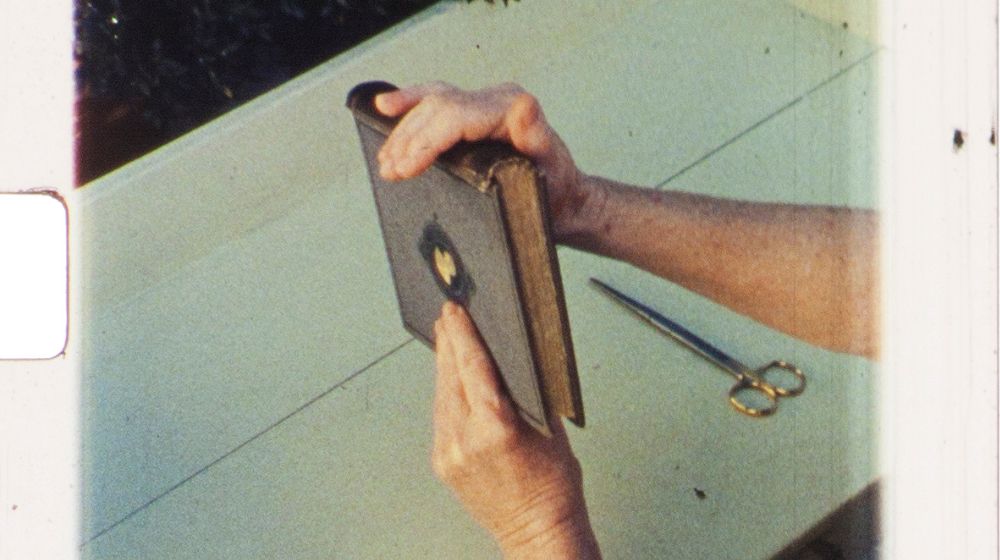Xcèntric 2023-2024
Project for a text
Audiovisuals
A menu of films to think about the relationship between writing and cinema, two areas that are not contradictory in this programme—quite the opposite. Many of them show the space and gestures typical of text creation in analogy with cinematographic procedures. In this way they propose the written word as a form of filmic image, intertwining the tasks of the writer and the filmmaker.
The film La pluie (Projet pour un texte), by Marcel Broodthaers, is one of the many works by this Belgian artist in which writing is related to other artistic forms. This film, in which we see Broodthaers himself trying to write in the rain, the water constantly washing away the ink, shows how any attempt to recreate the literary gesture takes the cinema and the text to the limit.
Poetic Justice, the second film in the series Hapax Legomena (1971-1972), by Hollis Frampton, explores the nature of cinema through the relationship between image and word. It draws us into the space habitually associated with writing—a stack of papers, a cup of coffee and a potted cactus on a desk—, where we see, one by one, the handwritten pages that form a kind of script of a film that the viewer can only glimpse. But we only catch sight of the real action of the film, the writing of the text, off screen, in the tiny space that exists between frames.
It is no coincidence that João César Monteiro’s first film is a portrait of the writer Sophia de Mello Breyner Andresen, linking his cinema with literary creation from the outset. Realizing that the poetic word cannot be filmed, the filmmaker seeks to get closer to the Portuguese poet by showing her in the space where her writing takes place, sitting at a table next to a window, a glass of water and a basket of fruit, with pencil and cigarette in hand. The film was made one summer with the lightness and humour of a film diary, in which we also see the writer with her children by the sea, a fundamental element in her literature and in Monteiro’s filmography.
As well as being materially presented among the images, books led Robert Beavers to make some films, as in the case of From the Notebook of…, which is based on the notebooks of Leonardo da Vinci, Paul Valéry’s essay about the artist, and the notes made by the filmmaker in the preparation of this work. In the film, Beavers portrays himself working in a space similar to that of a writer: a table beside a window, a notebook, filters and a camera. This led him to compare, as well as the movement of birds’ wings to the opening of the blinds, the turning of the pages of his handwritten notes to the movement of the shutter and the lenses of the camera.
Last up, Bruno Delgado Ramo’s film looks at the figure of thinker Baruch Spinoza and portrays the room where he worked. There, apart from writing one of his main treatises—Ethics—, which we see fragmented in volumes in the film, he spent his days working in the family nut importing business and grinding lenses for the manufacture of optical instruments.
La Pluie (Projet pour un texte), Marcel Broodthaers, 1969, 16 mm, silent, 2’; Poetic Justice (Hapax Legomena II), Hollis Frampton, 1972, 16 mm, silent, 31’; Sophia de Mello Breyner Andresen, João César Monteiro, 1969, 35 mm to DCP, 17’; From the Notebook of…, Robert Beavers, 1971-1998, 16 mm to DCP, 48’; Spinoza/Ongodist, Bruno Delgado Ramo, 2021, Super-8, 11’
Copy of La pluie courtesy of the MACBA. Copy of Poetic Justice from Light Cone. Copy of Sophia de Mello Breyner Andresen from the Cinemateca Portuguesa. Copies of From the Notebook of… and Spinoza/Ongodist courtesy of their respective filmmakers.
Directors: Marcel Broodthaers, Hollis Frampton, João César Monteiro, Robert Beavers, Bruno Delgado Ramo
This activity is part of Xcèntric 2023-2024



